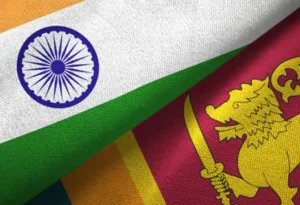GS II-International Relations

Significance for Both Countries
- Mutual Support at International Forums
- India supports Sri Lanka’s application to join BRICS.
- Sri Lanka backs India’s candidature for a non-permanent seat at the UN Security Council (2028–29).
- Shared Interests in the Indian Ocean Region (IOR)
- Strong commitment to freedom of navigation, countering traditional and non-traditional threats, and ensuring a safe, secure, and rules-based IOR.
- Energy Cooperation
- Ongoing discussions on:
- Inter-grid connectivity
- Multi-product petroleum pipeline
- LNG supply
- Sampur Power Project
- Regional and Multilateral Platforms
- Joint participation in:
- Indian Ocean Rim Association (IORA)
- BIMSTEC
- Military Collaboration
- Joint Military Exercises:
- SLINEX (Navy) and MITRA SHAKTI (Army) conducted annually.
- Sri Lanka also takes part in MILAN, a multilateral naval exercise hosted by India.
Significance for Sri Lanka
- Debt Restructuring and Financial Assistance
- India provided ~$4 billion in aid during Sri Lanka’s 2022–23 economic crisis.
- Co-chair of the Official Creditors’ Committee (OCC) with France and Japan to restructure debt.
- IMF Bailout Support: India was among the first to give financing assurances for Sri Lanka’s $2.9 billion IMF bailout (2023).
- Grant Assistance
- $20.66 million grant to clear payments of 7 completed Line of Credit projects.
- Kankesanthurai Port rehabilitation to be executed via Indian grant support.
- Economic Partnership
- India is Sri Lanka’s largest trading partner, leading FDI contributor, and top source of tourists.
- Humanitarian & Capacity Support
- India is a ‘first responder’ in disasters and crises.
- Support includes:
- Colombo Security Conclave initiatives.
- Installation of Maritime Rescue Coordination Centre (MRCC).
- Cultural collaborations (e.g., Thiruketheeswaram Temple restoration, Kapilavastu relics exposition).
India’s Strategic Interests
- Geostrategic Importance
- Sri Lanka is India’s closest maritime neighbour and crucial for Indian Ocean security.
- Prevents external powers from using its territory against India.
- Neighbourhood First & SAGAR Policies
- Bilateral engagement aligns with India’s Neighbourhood First and SAGAR (Security and Growth for All in the Region) visions.
- Indian-Origin Tamils (IOTs)
- Approx. 1.6 million IOTs live in Sri Lanka, mainly in plantations and businesses, especially around Colombo.
Challenges in India–Sri Lanka Relations
- Chinese Strategic Presence
- China’s influence via infrastructure projects like Hambantota Port and Colombo Port City.
- Frequent docking of Chinese surveillance vessels (e.g., Yuan Wang-5, Shi Yan-6) raises security concerns for India.
- Fishermen Disputes
- Use of bottom trawling by Indian fishermen is opposed by Sri Lanka.
- Disputes over maritime boundaries and Kachchatheevu Island (ceded in 1974) remain unresolved.
- Delayed 13th Amendment Implementation
- Originating from the Indo-Lanka Accord (1987) for devolution of power to provinces.
- India supports implementation, but Sinhala nationalists oppose and Tamil groups seek broader autonomy.
Way Forward
Diplomatic & Strategic Engagement
- Uphold India’s Five “S” foreign policy:
Samman (Respect), Samvad (Dialogue), Sahyog (Cooperation), Shanti (Peace), and Samriddhi (Prosperity).
Addressing Chinese Influence
- Strengthen India’s presence via economic cooperation, security frameworks, and people-centric initiatives.
- SAGAR and Neighbourhood First policies should be guiding lights in countering Beijing’s assertiveness.
Resolving Fishermen Issues
- Shared Fishing Zones: Allow Indian fishermen within 5 nautical miles of IMBL in return for Lankan access to India’s EEZ.
- Regulated Trawling: Restrict days, hours, and distance to reduce ecological impact.
- Lease Kachchatheevu: A compromise allowing Indian access while retaining Sri Lankan sovereignty.
13th Amendment Implementation
- Opportunity for Sri Lanka to strengthen provincial devolution and improve ethnic reconciliation, with India’s support.
Conclusion
India–Sri Lanka relations have deep historical, ethnic, cultural, and economic roots. With evolving regional dynamics and the China factor, both nations need to deepen strategic engagement through trust-building, mutual respect, and cooperative frameworks to ensure peace and prosperity in the Indian Ocean Region.




